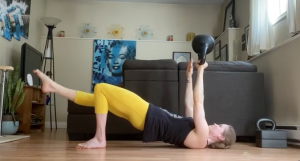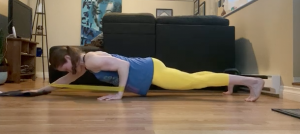Strong Shoulder Exercises for Life-Long Training
Today’s guest post comes from superstar trainer Meghan Callaway, author of the Ultimate Pushup Program and the Ultimate Pullup Program, both of which are on sale from today August 4th until August 9th at midnight for a slick 50% off the regular price.
*****
If you want to train consistently and achieve top results, having strong, mobile, and durable shoulders is a must. Being able to control the movement of the shoulder blades is also vital if you wish to perform push-ups using proper form.
When many people perform push-ups, and this includes people of all genders, fitness levels and abilities, it’s common to see elbows flaring out, shoulders rolling forward or shrugging towards the ears, or the shoulder blades winging out or caving in. Other people lock their shoulder blades in a fixed position so they are forced to perform reps using a tiny range of motion, also known as “cheat reps.” None of the above is conducive to achieving optimal results.
Without further ado, here are 4 exercises for stronger, more mobile and durable shoulders. I am guessing you have not seen some of these exercises before.
#1) Single Leg Isometric Glute Bridge + Bottoms-Up Kettlebell Screwdrivers + Single Leg Lowering

This exercise provides a huge bang for your buck and improves shoulder and scapular controlled mobility, lumbo-pelvic stability, grip strength, and strengthens the glutes.
Coaching Tips:
Set yourself up as you would when you are performing regular glute bridges.
Place your shin in a relatively vertical position.
Hold a kettlebell in a bottoms-up position, and perform a bottoms-up press. Make sure your shoulder blade remains in a protracted position for the duration for the exercise (move it away from your spine and around your ribcage).
Now extend your hips by pressing through the back portion of your foot and squeezing your glutes, NOT by arching your lower back. Your body should form a straight line from your knee to shoulders. Maintain this position for the duration of the exercise.
Extend your other leg so it is in a vertical position. If you cannot fully extend your knee, or if you are unable to maintain proper form, you can keep your knee bent at a 90 degree angle.
Slowly lower your leg to a range that allows you to maintain proper form. Once you hit your end range, return your leg back to the starting position.
For the duration of the exercise, perform kettlebell screwdrivers. In the starting position your palm should be in a neutral position. While looking at the kettlebell the entire time, rotate your wrist, forearm and elbow so your palm is facing away from you. Pause for a count, then perform the reverse movements and rotate the kettlebell so your palm is facing you.
Do not allow your lower back to hyperextend, ribcage to flare, torso, spine, or hips to rotate, or hips to drop.
For the duration of the exercise, keep your core muscles braced (360 degree brace), and contract your glutes.
#2) Single Arm Push-Up Iso Hold + Band Resisted Towel Slides

This advanced exercise strengthens the chest, shoulders and triceps, improves shoulder and scapular controlled mobility (and stability on the planted side), and lumbo-pelvic stability.
Coaching Tips:
Place a resistance band around your wrists, and place one hand on a towel.
Get into the bottom position of a push-up.
Your elbows should be positioned over your wrists, and forearms in a vertical position. Do not allow your elbows to flare out.
On the planted side, your weight should be evenly distributed throughout your full hand and fingers, not just at the base of your hand/wrist. Pretend you are trying to spread your full hand and fingers to the floor.
While holding in a single arm push-up position, perform a slide out with the other side. Go to a range where you are able to maintain proper form.
Do not allow your lower back to hyperextend, ribcage to flare, torso, spine or hips to rotate, hips to collapse or pike, or neck to collapse.
For the duration of the exercise, keep your core muscles braced (360 degree brace), and contract your glutes.
#3) Scapula Protractions With Roller From Knees

This exercise improves shoulder and scapular controlled mobility, lumbo-pelvic stability, and wrist stability.
Coaching Tips:
Get on all fours. Your head, torso and hips should be in a stacked position. Tuck your chin, and keep your neck in a neutral position.
Place one hand so it is on top of a foam roller or other surface.
Your shoulders, elbows and wrists should be in a stacked position.
Your weight should be evenly distributed throughout your full hand and fingers, not just at the base of your hand/wrist. Pretend you are trying to spread your full hand and fingers to the roller.
In the starting/top position, press your body away from the roller and protract your shoulder blade. Think about moving your shoulder blade away from your spine and around your ribcage.
Now without bending your elbow or reaching down with the non/working arm, retract your shoulder blade and lower your body towards the floor, and touch your hand on the non-working side to the floor. Think about lightly moving your shoulder blade in towards your spine. Do not just drop down.
Once you reach the bottom position, press your body away from the roller, protract your shoulder blade, and return to the top position.
You may either lightly touch your fingertips on the non-working side to the floor and use minimal assistance, or you may touch your full hand to the floor and use more assistance.
Aside from the shoulder and shoulder blade on the side of your body that is in contact with the roller, the rest of your body should remain in a relatively fixed position for the duration of the exercise.
Do not allow your shoulders to shrug towards your ears, round, or collapse.
Do not allow your lower back to hyperextend, ribcage to flare, torso, spine or hips to rotate, hips to collapse or pike, or neck to collapse.
#4) Prone Bodyweight Serratus/Trap Drags + Band Resistance

This exercise improves shoulder and scapular controlled mobility, and strengthens the muscles in the mid and upper back. An added bonus that is not related to push-ups, this is also a great way to practice pull-ups if you do not have access to a bar.
Coaching Tips:
Fasten a resistance band around a secure surface, and loop the band around your ankles. Or you may do what I did, and may secure the band by putting one end under a closed door. There should be resistance in the band for 100% of the exercise.
In the starting position, your arms should be fully extended and in an overhead position.
Now draw your shoulder blades in towards your spine and down towards the opposite hip, and pull your body forward. When you reach the end position, your elbows should be at approximately a 45 degree angle with your torso, and you should really feel the muscles around your shoulder blades and lats working.
Gain a moment of control, then perform the reverse movements and press your body backwards so your arms return to an overhead and fully extended position.
Do not keep your shoulder blades pinned. They are meant to move. Do not allow your shoulders to shrug towards your ears. Keep your shoulder blades depressed.
Meghan’s resource, The Ultimate Pushup Program, includes these and many more exercises, plus thorough walk throughs on how to perform the best pushup, get your first, or hit a new PR in pushups, plus all the ways to keep your shoulders, wrists and elbows healthy during the training too. Get it for 50% off until August 9th.

You can also pick up her Ultimate Pullup Program for the best upper body training program possible. The combo pack with both options is also 50% off until August 9th, so get it now while it’s good and cheap.